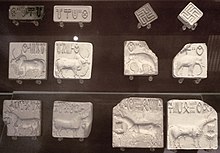The term Indus script (also Harappan script) refers to short strings of symbols associated with the Indus Valley Civilization, in use during the Mature Harappan period, between the 26th and 20th centuries BC. In spite of many attempts at decipherments and claims, it is as yet undeciphered and its interpretation as writing has been contested. The underlying language is unknown, and the lack of a bilingual inscription makes the decipherment unlikely pending significant new finds.
The first publication of a Harappan seal dates to 1873, in the form of a drawing by Alexander Cunningham. Since then, well over 4000 symbol-bearing objects have been discovered, some as far afield as Mesopotamia. In the early seventies Iravatham Mahadevan published a corpus and concordance of Indus writing listing about 3700 seals and about 417 distinct sign in specific patterns. The average size of writing is five signs and largest text in a single line is 17 signs. He also established the direction of writing as right to left.
